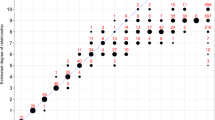Abstract
The cause of ALS remains largely unknown for the 90% with no known family history, but spontaneous mutation to risk alleles of as yet unidentified genes is possible. It has long been recognized that genetic diseases may be more likely to occur in the last born children of a sibship because increased paternal age is associated with an increased spontaneous point mutation rate in sperm. To test the hypothesis that such a mechanism is responsible for sporadic ALS, we have performed a retrospective analysis of birth order position. We have analyzed sibships of size greater than four using a binomial test for birth position. The 478 pedigrees studied show no birth order effect, suggesting that any genetic contributions to sporadic ALS are more likely to be through deletion in large genes or interactions of common polymorphisms, rather than frequent spontaneous point mutation. This is encouraging for the prospect of finding sporadic ALS susceptibility genes using genome-wide association mapping.
Similar content being viewed by others
References
Turner MR, Parton MJ, Shaw CE, Leigh PN, Al-Chalabi A (2003) Prolonged survival in motor neuron disease: a descriptive study of the King’s database 1990–2002. J Neurol Neurosurg Psychiatry 74:995–997
Kurland LT, Mulder DW (1955) Epidemiological investigations of amyotrophic lateral sclerosis: Familial aggregations indicative of autosomal dominant inheritance, parts I and II. Neurology, pp 182–269
Rosen DR (1993) Mutations in Cu/Zn superoxide dismutase gene are associated with familial amyotrophic lateral sclerosis. Nature 364:362–362
Jones CT, Swingler RJ, Brock DJ (1994) Identification of a novel SOD1 mutation in an apparently sporadic amyotrophic lateral sclerosis patient and the detection of Ile113Thr in three others. test 3:649–650
Andersen PM, Nilsson P, Keranen ML, Forsgren L, Hagglund J, Karlsborg M, Ronnevi LO, Gredal O, Marklund SL (1997) Phenotypic heterogeneity in motor neuron disease patients with CuZn-superoxide dismutase mutations in Scandinavia. Brain 10:1723–1737
Jackson M, Al-Chalabi A, Enayat ZE, Chioza B, Leigh PN,Morrison KE (1997) Copper/zinc superoxide dismutase 1 and sporadic amyotrophic lateral sclerosis: analysis of 155 cases and identification of a novel insertion mutation. Annals of Neurology 42:803–807
Alexander MD, Traynor BJ,Miller N, Corr B, Frost E,McQuaid S, Brett FM, Green A,Hardiman O (2002) “True” sporadic ALS associated with a novel SOD-1 mutation. Ann Neurol 52:680–683
Weinberg W (1912) Zur Vererbung des Zwergwuches. Arch Rassen Gesellschaftsbiol 9:710–718
Penrose LS (1955) Parental age and mutation. Lancet 269:312–313
Risch N, Reich EW, Wishnick MM, McCarthy JG (1987) Spontaneous mutation and parental age in humans. Am J Hum Genet 41:218–248
Crow JF (2000) The origins, patterns and implications of human spontaneous mutation. Nat Rev Genet 1:40–47
Olshan AF, Schnitzer PG, Baird PA (1994) Paternal age and the risk of congenital heart defects. Teratology 50:80–84
Zhang Y, Kreger BE, Dorgan JF, Cupples LA, Myers RH, Splansky GL, Schatzkin A, Ellison RC (1999) Parental age at child’s birth and son's risk of prostate cancer. The Framingham Study. Am J Epidemiol 150:1208–1212
Grimm T, Meng G, Liechti-Gallati S, Bettecken T, Muller CR, Muller B (1994) On the origin of deletions and point mutations in Duchenne muscular dystrophy: most deletions arise in oogenesis and most point mutations result from events in spermatogenesis. J Med Genet 31:183–186
Johnston CA, Stanton BR, Turner MR, Gray R, Blunt AH-M, Butt D, Ampong MA, Shaw CE, Leigh PN, Al-Chalabi A (2006) Amyotrophic Lateral Sclerosis in an Urban Setting: A Population Based Study of Inner City London. Journal of Neurology (In press)
Meyer T, Alber B, Roemer K,Martin T, Kalscheuer VM,Gottert E, Zang KD, Ludolph AC, Ropers HH, Prudlo J (2003) High rate of constitutional chromosomal rearrangements in apparently sporadic ALS. Neurology 60:1348–1350
Author information
Authors and Affiliations
Corresponding author
Rights and permissions
About this article
Cite this article
Vivekananda, U., Johnston, C., McKenna-Yasek, D. et al. Birth order and the genetics of amyotrophic lateral sclerosis. J Neurol 255, 99–102 (2008). https://doi.org/10.1007/s00415-007-0709-2
Received:
Revised:
Accepted:
Published:
Issue Date:
DOI: https://doi.org/10.1007/s00415-007-0709-2




